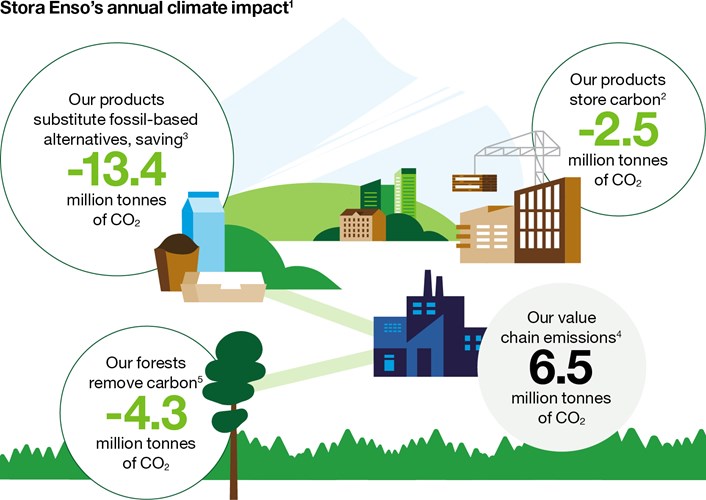Long a part of the global bioeconomy, Stora Enso is a leading provider of renewable solutions and one of the largest private forest owners in the world. Sustainably managed forests have a positive climate impact, both as carbon sinks and through circular end products.

Do you want to know more about Stora Enso?
Our goal is to provide our customers with 100% regenerative solutions by 2050, proactively contributing to solving global issues by looking at how positive sustainability impacts can be accelerated.
Today, we offer sustainable, renewable alternatives to fossil-based solutions. In the future, our innovations, product development, and investments in energy and raw material efficiency will help customers to reach their climate targets as well as meet consumer demands for low-carbon products.
When forests are managed sustainably, growing trees absorb carbon dioxide from the atmosphere. In comparison, fossil-based materials cannot be renewed. When consumed, they release fossil CO2 into the atmosphere and heat our planet.
It is crucial that the wood we use comes from sustainably managed forests and that more new trees are planted than harvested to regenerate the forest. Growing trees remove carbon dioxide from the atmosphere, and the carbon cycle continues.
Sustainable forestry also takes into account working to enhance forest biodiversity, so we create healthy ecosystems to halt and reverse biodiversity loss. Having high diversity of species in forests promotes healthy growth to keep storing carbon, and also protects the forests against adverse impacts from climate warming.
When trees are harvested, the carbon stored in the wood fibers is not released immediately but continues to be stored in products made from that wood. How long the carbon remains stored in the fibers depends on how long the product stays in use. With wooden buildings, for example, the timespan is decades, even centuries.
“Substitution effect” refers to emissions that can be avoided, because a renewable material originating from a sustainably managed source is chosen instead of a fossil-based one. When renewable materials replace fossil-based ones, it reduces the overall climate impact of the product. Lifecycle analyses show that paperboard trays, for instance, have up to a 67% lower carbon footprint than traditional plastic trays.
The renewable packaging market is growing faster than plastics-based alternatives now for the first time. This accelerating shift is increasing the demand for high performing renewable packaging.
In the construction sector, wood will play a crucial role, as wood results in less carbon emissions than manufacturing concrete and steel, and buildings made of wood store carbon. One tonne of carbon is stored per every cubic meter of buildings engineered with wood. Essentially, buildings and cities can become carbon-storage infrastructures.
Some fossil-based materials are hard to replace, but new solutions are available or in the pipeline. Lignin, a part of wood still largely unutilised, can replace fossil-based materials in glues and even batteries. Bio-barriers already replace plastics in packaging as highly functional renewable materials. In the future, entire cars could be made from wood-based materials, such as bio-carbon fiber.

1 Negative value indicates a net removal from atmosphere. Calculated by the Swedish University of Agricultural Sciences (SLU) based on Stora Enso’s forest and production figures: Climate effects of a forestry company – including biogenic carbon fluxes and substitution effects (2021 update).
2 Net annual carbon sequestration with forward-looking simulation in Stora Enso’s forest assets. Excludes purchased wood from third-party forest owners, whose forests are estimated to have an additional net carbon sequestration of –5 million tonnes of CO2 annually. For more information, see also Accounting principles for Sustainable forestry and biodiversity.
3 Stora Enso’s fossil CO2e emissions in 2022 including direct emissions from our operations, emissions from purchased energy as well as emissions from other sources along our value chain (scope 1, 2, and 3). Calculated based on the guidance provided by the Greenhouse Gas Protocol.
We have committed to science-based targets that are aligned with the 1.5-degree target. We work to halve our absolute direct fossil CO2e emissions from production and the indirect fossil CO2e emissions related to purchased electricity and heat. Additionally, we have committed to an ambitious target to halve the emissions of all other sources along our value chain – so called scope 3 greenhouse gas (GHG) emissions.
The target is to reduce 50% of our greenhouse gas (GHG) emissions from the 2019 base-year, on all scopes1) from own emissions to those along our value chains by 2030. The science-based targets have been approved by the Science Based Targets initiative, a partnership between CDP, the United Nations Global Compact (UNGC), the World Resources Institute (WRI) and the World Wide Fund for Nature (WWF).
1) Scope 1: Direct fossil CO2e emissions from production. Scope 2: Indirect fossil CO2e emissions related to purchased electricity and heat. Scope 3: Emissions from other sources along our value chain.